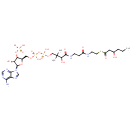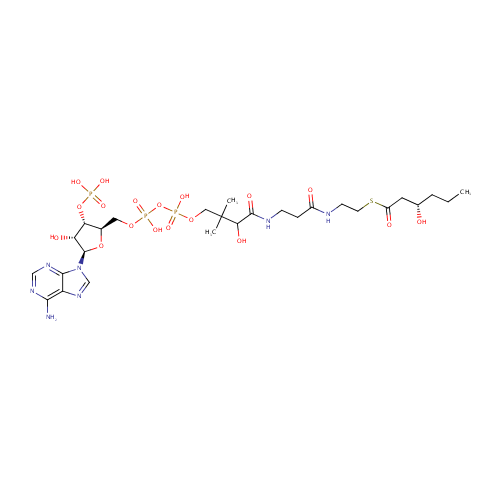|
Record Information |
|---|
| Version |
1.0 |
|---|
| Update Date |
1/22/2018 11:54:54 AM |
|---|
|
Metabolite ID | PAMDB000538 |
|---|
|
Identification |
|---|
| Name: |
(S)-Hydroxyhexanoyl-CoA |
|---|
| Description: | (S)-Hydroxyhexanoyl-CoA is an intermediate in fatty acid metabolism, being the substrate of the enzymes beta-hydroxyacyl-CoA dehydrogenase and 3-hydroxyacyl-CoA dehydrogenase [EC 1.1.1.211-1.1.1.35]; (S)-Hydroxyhexanoyl-CoA is an intermediate in fatty acid elongation, the substrate of the enzymes enoyl-CoA hydratase and long-chain-enoyl-CoA hydratase [EC 4.2.1.17-4.2.1.74]. (KEGG) |
|---|
|
Structure |
|
|---|
| Synonyms: | - (S)-3-Hydroxyhexanoyl-CoA
- (S)-3-Hydroxyhexanoyl-Coenzyme A
- S-(3-hydroxyhexanoate
- S-(3-Hydroxyhexanoate)
- S-(3-Hydroxyhexanoate)CoA
- S-(3-Hydroxyhexanoate)Coenzyme A
- S-(3-hydroxyhexanoic acid
- S-(3-Hydroxyhexanoic acid)
- S-(3-Hydroxyhexanoic acid)CoA
- S-(3-Hydroxyhexanoic acid)coenzyme A
- [R,S]-Lactyl CoA
- [R,S]-Lactyl Coenzyme A
|
|---|
|
Chemical Formula: |
C27H46N7O18P3S |
|---|
| Average Molecular Weight: |
881.677 |
|---|
| Monoisotopic Molecular
Weight: |
881.183287929 |
|---|
| InChI Key: |
VAAHKRMGOFIORX-DWUFXMDISA-N |
|---|
| InChI: | InChI=1S/C27H46N7O18P3S/c1-4-5-15(35)10-18(37)56-9-8-29-17(36)6-7-30-25(40)22(39)27(2,3)12-49-55(46,47)52-54(44,45)48-11-16-21(51-53(41,42)43)20(38)26(50-16)34-14-33-19-23(28)31-13-32-24(19)34/h13-16,20-22,26,35,38-39H,4-12H2,1-3H3,(H,29,36)(H,30,40)(H,44,45)(H,46,47)(H2,28,31,32)(H2,41,42,43)/t15-,16+,20+,21+,22?,26+/m0/s1 |
|---|
| CAS
number: |
74875-70-0 |
|---|
| IUPAC Name: | {[(2R,3S,4R,5R)-5-(6-amino-9H-purin-9-yl)-4-hydroxy-2-({[hydroxy({hydroxy[3-hydroxy-3-({2-[(2-{[(3S)-3-hydroxyhexanoyl]sulfanyl}ethyl)carbamoyl]ethyl}carbamoyl)-2,2-dimethylpropoxy]phosphoryl}oxy)phosphoryl]oxy}methyl)oxolan-3-yl]oxy}phosphonic acid |
|---|
|
Traditional IUPAC Name: |
[(2R,3S,4R,5R)-5-(6-aminopurin-9-yl)-4-hydroxy-2-[({hydroxy[hydroxy(3-hydroxy-3-({2-[(2-{[(3S)-3-hydroxyhexanoyl]sulfanyl}ethyl)carbamoyl]ethyl}carbamoyl)-2,2-dimethylpropoxy)phosphoryl]oxyphosphoryl}oxy)methyl]oxolan-3-yl]oxyphosphonic acid |
|---|
| SMILES: | CCC[C@H](O)CC(=O)SCCNC(=O)CCNC(=O)C(O)C(C)(C)COP(O)(=O)OP(O)(=O)OC[C@H]1O[C@H]([C@H](O)[C@@H]1OP(O)(O)=O)N1C=NC2=C(N)N=CN=C12 |
|---|
|
Chemical Taxonomy |
|---|
|
Taxonomy Description | This compound belongs to the class of organic compounds known as 3-hydroxyacyl coas. These are organic compounds containing a 3-hydroxyl acylated coenzyme A derivative. |
|---|
|
Kingdom |
Organic compounds |
|---|
| Super Class | Lipids and lipid-like molecules |
|---|
|
Class |
Fatty Acyls |
|---|
| Sub Class | Fatty acyl thioesters |
|---|
|
Direct Parent |
3-hydroxyacyl CoAs |
|---|
| Alternative Parents |
|
|---|
| Substituents |
- Coenzyme a or derivatives
- Purine ribonucleoside diphosphate
- Purine ribonucleoside 3',5'-bisphosphate
- N-glycosyl compound
- Glycosyl compound
- Beta amino acid or derivatives
- Organic pyrophosphate
- Monosaccharide phosphate
- 6-aminopurine
- Purine
- Imidazopyrimidine
- Monoalkyl phosphate
- Aminopyrimidine
- Imidolactam
- Alkyl phosphate
- Pyrimidine
- Primary aromatic amine
- Phosphoric acid ester
- Organic phosphoric acid derivative
- Organic phosphate
- N-substituted imidazole
- N-acyl-amine
- Monosaccharide
- Fatty amide
- Saccharide
- Heteroaromatic compound
- Oxolane
- Imidazole
- Azole
- Thiocarboxylic acid ester
- Secondary carboxylic acid amide
- Secondary alcohol
- Carboxamide group
- Oxacycle
- Azacycle
- Organoheterocyclic compound
- Sulfenyl compound
- Thioether
- Thiocarboxylic acid or derivatives
- Carboxylic acid derivative
- Carboxylic acid amide
- Hydrocarbon derivative
- Primary amine
- Organosulfur compound
- Organooxygen compound
- Organonitrogen compound
- Carbonyl group
- Amine
- Alcohol
- Aromatic heteropolycyclic compound
|
|---|
| Molecular Framework |
Aromatic heteropolycyclic compounds |
|---|
| External Descriptors |
|
|---|
|
Physical Properties |
|---|
| State: |
Solid |
|---|
| Charge: | -4 |
|---|
|
Melting point: |
Not Available |
|---|
| Experimental Properties: |
|
|---|
| Predicted Properties |
|
|---|
|
Biological Properties |
|---|
| Cellular Locations: |
Cytoplasm |
|---|
| Reactions: | |
|---|
|
Pathways: |
|
|---|
|
Spectra |
|---|
| Spectra: |
|
|---|
|
References |
|---|
| References: |
- Dalluge JJ, Gort S, Hobson R, Selifonova O, Amore F, Gokarn R: Separation and identification of organic acid-coenzyme A thioesters using liquid chromatography/electrospray ionization-mass spectrometry. Anal Bioanal Chem. 2002 Nov;374(5):835-40. Epub 2002 Oct 8. Pubmed: 12434239
- Hofmeister AE, Buckel W: (R)-lactyl-CoA dehydratase from Clostridium propionicum. Stereochemistry of the dehydration of (R)-2-hydroxybutyryl-CoA to crotonyl-CoA. Eur J Biochem. 1992 Jun 1;206(2):547-52. Pubmed: 1597194
- Kanehisa, M., Goto, S., Sato, Y., Furumichi, M., Tanabe, M. (2012). "KEGG for integration and interpretation of large-scale molecular data sets." Nucleic Acids Res 40:D109-D114. Pubmed: 22080510
- Kim J, Hetzel M, Boiangiu CD, Buckel W: Dehydration of (R)-2-hydroxyacyl-CoA to enoyl-CoA in the fermentation of alpha-amino acids by anaerobic bacteria. FEMS Microbiol Rev. 2004 Oct;28(4):455-68. Pubmed: 15374661
- Klees AG, Linder D, Buckel W: 2-Hydroxyglutaryl-CoA dehydratase from Fusobacterium nucleatum (subsp. nucleatum): an iron-sulfur flavoprotein. Arch Microbiol. 1992;158(4):294-301. Pubmed: 1417419
- Kuchta RD, Abeles RH: Lactate reduction in Clostridium propionicum. Purification and properties of lactyl-CoA dehydratase. J Biol Chem. 1985 Oct 25;260(24):13181-9. Pubmed: 4055736
- Kuchta RD, Hanson GR, Holmquist B, Abeles RH: Fe-S centers in lactyl-CoA dehydratase. Biochemistry. 1986 Nov 18;25(23):7301-7. Pubmed: 3026450
- Megraw RE, Reeves HC, Ajl SJ: Formation of lactyl-coenzyme A and pyruvyl-coenzyme A from lactic acid by Escherichia coli. J Bacteriol. 1965 Oct;90(4):984-8. Pubmed: 5321404
- Sokatch JR: Alanine and aspartate formation during growth on valine-C14 by Pseudomonas aeruginosa. J Bacteriol. 1966 Jul;92(1):72-5. Pubmed: 4957438
|
|---|
| Synthesis Reference: |
Tamvakopoulos, Constantine S.; Anderson, Vernon E. Detection of acyl-coenzyme A thioester intermediates of fatty acid b-oxidation as the N-acylglycines by negative-ion chemical ionization gas chromatography mass spectrometry. Analytical Biochemistry |
|---|
| Material Safety Data Sheet (MSDS) |
Not Available |
|---|
|
Links |
|---|
| External Links: |
|
|---|


